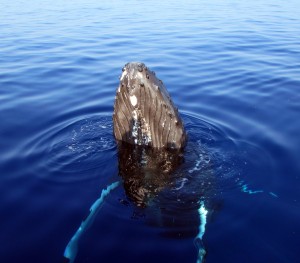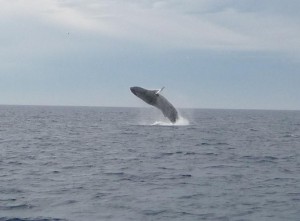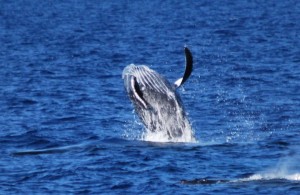Aloha,
We had a great day on the water on Thursday. With five different cruises just for Whale Watching, plus a couple of Snorkel Cruises thrown in, there’s way too much to report for one email, so I’ll just give you a few highlights. Though the surf was up today, the wind was very, very calm, allowing us to see for miles. There were lots of Humpbacks visible all day long — on our Wake up With the Whales Cruises (we took both Seasmoke and Manu Iwa out), we all saw a few breaches and lots of great fluke dives. On our Kid’s Educational Whale Watch Cruise, the kids (and parents and teachers from Wai’aha International Family School) got to see 3 spy hops about 100 yards from the boat. We also saw a pretty big peduncle throw. On our Whales and Cocktails Cruise we had several close encounters with adult Humpbacks, and when we stopped the boat we could actually hear the whales singing through the hulls. After we were serenaded for several minutes, we decided to deploy the hydrophone and our close-by singer was certainly the star of the show. He was making some groaning, clicking, and squealing sounds that were new to us (along with the “whooop, whoop, whoooooop” sounds we were familiar with from last year. The best part was when the singing stopped briefly. We knew he was on the way up, and he surfaced just 50 yards from us!
Mahalo and have a great weekend. I’ll send out a recap on Monday.
Claire
Captain Claire’s Humpback Fact of the Day: Yesterday, I mentioned that researchers estimated a Humpback’s daily fish consumption during the summer season to be on the order of 2000 pounds per day. And if you do a quick Google search you’ll find that “fact” cited all over the place. Turns out that this may be just another example of how inaccurate information gets spread. Once a “fact” is listed in a book, it’s picked up on the internet and its spread can be exponential.
According to researcher Briana H. Witteveen and her colleagues who conducted a study to determine the effect of Humpback predation on fish abundance near Kodiak Alaska, based on the documented stomach contents of Humpbacks “processed” through whaling stations back in 1937, combined with estimates of actual suitable prey availability, an average size Humpback whale is eating more on the order of 800 pounds (or about 576,000 calories) of food each day.Does that seem like a lot of food to you?




